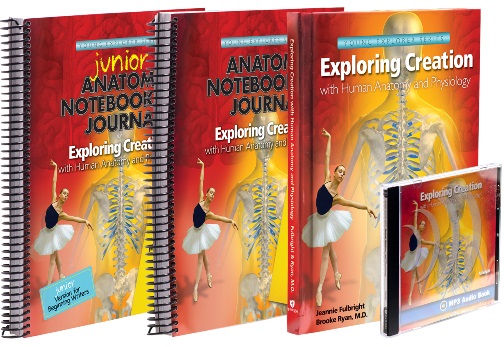
- Introduction to Anatomy and Physiology
- The Skeletal System
- The Muscular System
- The Digestive and Renal Systems
- Health and Nutrition
- The Respiratory System
- Life in the Blood
- The Cardiovascular System
- The Nervous and Endocrine Systems
- The Nervous System Extended
- Your Senses
- The Integumentary System
- The Lymphatic and Immune Systems
- Growth and Development
The MP3 audio CD is a recording of the author, Jeannie Fulbright, reading the text aloud. Her voice is soothing and the kids enjoyed listening to her. While the CD was playing, my kids read along in the textbook and looked at the graphics. However, as with any read aloud we do, my children like to stop and discuss everything we read. It took a little longer for us to get through the material when we had to keep starting and stopping the CD so they could talk or ask questions. My children prefer to just read the text aloud or have me read it aloud to them so we can more naturally discuss the material as we go along. That is just the way we do read alouds together. I think the CD would be great for other families, especially a student studying this independently or if you wanted to just play the CD in the car.
There are two Notebooking Journals available. The regular one is intended for older children which I let Nicholas complete. It contains more review questions and a vocabulary crossword puzzle. The Junior Notebooking Journal contains some coloring pages for each lesson and less writing on most of the other notebook pages. Rachel is in third grade and she likes the Junior version better although I think she is old enough to do fine with the regular version but it would definitely take her a little more time to complete.
For example, here is a crossword puzzle that Nicholas completed using vocabulary from lesson one.
But with the Junior version, Rachel just had to glue the vocabulary word on the definition to create a lift-the-flap page.
I just love that each lesson has a scripture copywork page that relates to the lesson in some way. Both journals offer a sample copywork in both manuscript and cursive so your child can complete which ever one is a better fit for them.
But my favorite part of the Notebooking Journals are the mini-books. Both the regular version and the Junior versions contain these. Check out my video below to see two examples.
For example, here is a crossword puzzle that Nicholas completed using vocabulary from lesson one.
But with the Junior version, Rachel just had to glue the vocabulary word on the definition to create a lift-the-flap page.
I just love that each lesson has a scripture copywork page that relates to the lesson in some way. Both journals offer a sample copywork in both manuscript and cursive so your child can complete which ever one is a better fit for them.
But my favorite part of the Notebooking Journals are the mini-books. Both the regular version and the Junior versions contain these. Check out my video below to see two examples.
Each lesson in the textbook gives an easy-to-read explanation of the various systems along with several "Try This!" demonstrations and experiments. The experiments are easy to follow and they use materials that you most likely already have at home. Here are just a few that we did in the first couple of lessons.
As they learned about the history of the study of anatomy, they learned about how ancient Egyptians embalmed bodies with salts to preserve them because they believed the bodies would be needed in the afterlife. So the kids did an experiments with various ratios of table salt, epsom salt, baking soda, and a control to see which mixture was the most effective at drying out apple slices. This was a really fun experiment!
After learning about the invention of glass lenses and microscopes, they did an experiment with a drop of water to demonstrate how a magnifying glass works.

When they learned about the different organelles inside the human cell, they used jello and various kinds of candy to make an edible cell. Yum!
To demonstrate the importance of our skeletal system, the children made clay people. First they made one without any "bones". He fell over right after I took his picture. Second, they made one with a toothpick skeletal system and he is still standing today.
Did you know that your arm span is about the same width as your body is tall? The children learned that and then did the "Try This!" demonstration to measure it for themselves.
In summary, we love this curriculum. It is a great introduction to anatomy and the demonstrations make it a fun and more memorable way to learn. I also appreciate that Apologia offers different notebooking journals for different ages. We have also enjoyed the fact that the curriculum gives some additional projects and reading materials for each lesson in case your student wants to dive in deeper with a particular topic.

We have used the Apologia Young Explorer series for most of our science curriculum. However, here are two other Apologia products that I have reviewed in the past:
If you would like to read some additional reviews about the Apologia Exploring Creation with Human Anatomy and Physiology products from other reviewers on the Homeschool Review Crew, please click on the banner below:









No comments:
Post a Comment